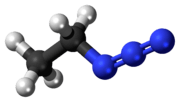Ethyl azide
 | |
 | |
| Names | |
|---|---|
| IUPAC name
Azidoethane | |
| Other names
Ethane, azido-; 1-Azidoethane | |
| Identifiers | |
| 871-31-8 | |
| 3D model (Jmol) | Interactive image |
| ChemSpider | 71449 |
| PubChem | 79118 |
| |
| |
| Properties | |
| C2H5N3 | |
| Molar mass | 71.08 |
| Appearance | liquid |
| Boiling point | 50 |
| Explosive data | |
| Shock sensitivity | High |
| Friction sensitivity | High |
| Thermochemistry | |
| Std enthalpy of formation (ΔfH |
266.872 |
| Hazards | |
| Main hazards | Harmful, Explosive |
| Related compounds | |
| Related compounds |
Hydrazoic acid, Chlorine azide, Methyl azide |
| Except where otherwise noted, data are given for materials in their standard state (at 25 °C [77 °F], 100 kPa). | |
| | |
| Infobox references | |
Ethyl azide (C2H5N3) is an explosive compound sensitive to rapid heating, shock or impact. It has exploded when heated to room temperature.[1][2] When heated to decomposition it emits toxic fumes of NOx.[3][4]
It is irritating to eyes, respiratory system and skin.
Uses
Ethyl azide is used in organic synthesis.
References
- ↑ Campbell, H. C.; Rice, O. K. (1935). "The Explosion of Ethyl Azide". Journal of the American Chemical Society. 57 (6): 1044–1050. doi:10.1021/ja01309a019.
- ↑ Rice, O. K.; Campbell, H. C. (1939). "The Explosion of Ethyl Azide in the Presence of Diethyl Ether". The Journal of Chemical Physics. 7 (8): 700–709. doi:10.1063/1.1750516.
- ↑ Rice, O. K. (1940). "The Role of Heat Conduction in Thermal Gaseous Explosions". The Journal of Chemical Physics. 8 (9): 727–733. doi:10.1063/1.1750808.
- ↑ Costa Cabral, B. J.; Costa, M. L.; Almoster Ferreira, M. A. (2010). "ChemInform Abstract: Molecular Structure and Ionization Energies of Azides: An ab initio Study of Hydrazoic Acid, Methyl Azide and Ethyl Azide". ChemInform. 24 (37): no. doi:10.1002/chin.199337053.
This article is issued from Wikipedia - version of the 11/1/2015. The text is available under the Creative Commons Attribution/Share Alike but additional terms may apply for the media files.